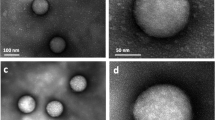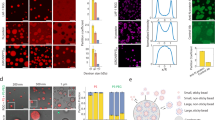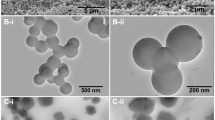Abstract
This article provides a brief review of the literature on the interaction between synthetic particles and biomacromolecules. Understanding the nonspecific interactions between biomacromolecules and synthetic particles is of great importance for using materials in vitro and in vivo. The interaction between functionalized polymer particles and proteins has been studied extensively to identify the main factor that governs the interaction in vitro. Recently, the composition and properties of the protein corona that forms on the surface of nanoparticles (NPs) in biofluids have been studied in the context of the function and distribution of the particles in vivo. In the meantime, NPs that recognize specific biomacromolecules have also been designed by tuning the combination and distribution of functional groups on gold NPs and dendrimers. It has also been shown that nano-gel particles that recognize target molecules can be achieved by (A) optimizing the combination and amount of functional groups in the particles and (B) molecular imprinting polymerization, in combination with (C) affinity purification. Some of these particles are capable of recognizing target molecules and neutralizing their function, even in the bloodstream of living animals, as ‘plastic antibodies.’
Similar content being viewed by others
Log in or create a free account to read this content
Gain free access to this article, as well as selected content from this journal and more on nature.com
or
References
Norde, W. & Lyklema, J. The adsorption of human plasma albumin and bovine pancreas ribonuclease at negatively charged polystyrene surfaces: I. Adsorption isotherms. Effects of charge, ionic strength, and temperature. J. Colloid Interface Sci. 66, 257–265 (1978).
Suzawa, T., Shirahama, H. & Fujimoto, T. Adsorption of bovine serum albumin onto homo- and copolymer lattices. J. Colloid Interface Sci. 86, 144–150 (1982).
Fair, B. D. & Jamieson, A. M. Studies of protein adsorption on polystyrene latex surfaces. J. Colloid Interface Sci. 77, 525–534 (1980).
Bagchi, P. & Birnbaum, S. M. Effect of pH on the adsorption of immunoglobulin G on anionic poly(vinyltoluene) model latex particles. J. Colloid Interface Sci. 83, 460–478 (1981).
de Bruin, H. G., van Oss, C. J. & Absolom, D. R. Desorption of protein from polystyrene latex particles. J. Colloid Interface Sci. 76, 254–255 (1980).
Van Dulm, P., Norde, W. & Lyklema, J. Ion participation in protein adsorption at solid surfaces. J. Colloid Interface Sci. 82, 77–82 (1981).
Koutsoukos, P. G., Mumme-Young, C. A., Norde, W. & Lyklema, J. Effect of the nature of the substrate on the adsorption of human plasma albumin. J. Colloids Surf. 5, 93–104 (1982).
Kawaguchi, H., Amagasa, H., Hagiya, T., Kimura, N. & Ohtsuka, Y. Interaction between proteins and latex particles having different surface structures. Colloids Surf. 13, 295–311 (1985).
Elgersma, A. V., Zsom, R. L. J., Norde, W. & Lyklema, J. The adsorption of bovine serum albumin on positively and negatively charged polystyrene lattices. J. Colloid. Interf. Sci. 138, 145–156 (1990).
Elgersma, A. V., Zsom, R. L. J., Norde, W. & Lyklema. The asorption of different types of monoclonal immunoglobulin on positively and negatively charged polystyrene lattices. J. Colloid Surf. 54, 89–101 (1991).
Kondo, A. & Higashitani, K. Adsorption of model proteins with wide variation in molecular properties on colloidal particles. J. Colloid Interface Sci. 150, 344–351 (1992).
Ortega-Vinuesa, J. L. & Hidalgo-Álvarez, R. Sequential adsorption of F(ab′)2 and BSA on negatively and positively charged polystyrene latexes. Biotechnol. Bioeng. 47, 633–639 (1995).
Yoon, J.-Y., Kim, W. S. & Kim, J.-H. The relationship of interaction forces in the protein adsorption onto polymeric microspheres. Colloids Surf. A 153, 413–419 (1999).
Pelton, R. H. & Chibante, P. Preparation of aqueous latices with N-isopropylacrylamide. Colloids Surf. 20, 247–256 (1986).
McPhee, W., Tam, K. C. & Pelton, R. Poly(N-isopropylacrylamide) latices prepared with sodium dodecyl sulfate. J. Colloid Interface Sci. 156, 24–30 (1993).
Pelton, R. Temperature-sensitive aqueous microgels. Adv. Colloid Interface Sci. 85, 1–33 (2000).
Ito, S., Ogawa, K., Suzuki, H., Wang, B. L., Yoshida, R. & Kokufuta, E. Preparation of thermosensitive submicrometer gel particles with anionic and cationic charges. Langmuir 15, 4289–4294 (1999).
Ogawa, K., Nakayama, A. & Kokufuta, E. Preparation and characterization of thermosensitive polyampholyte nanogels. Langmuir 19, 3178–3184 (2003).
Debord, J. D. & Lyon, L. A. Synthesis and characterization of pH-responsive copolymer microgels with tunable volume phase transition temperatures. Langmuir 19, 7662–7664 (2003).
Kawaguchi, H., Fujimoto, K. & Mizuhara, Y. Hydrogel microspheres III. Temperature-dependent adsorption of proteins on poly-N-isopropylacrylamide hydrogel microspheres. Colloid Polym. Sci. 270, 53–57 (1992).
Duracher, D., Elaissari, A., Mallet, F. & Pichot, C. Adsorption of modified HIV-1 capsid p24 protein onto thermosensitive and cationic core−shell poly(styrene)−poly(N-isopropylacrylamide) particles. Langmuir 16, 9002–9008 (2000).
Silva, C. S. O., Baptista, R. P., Santos, A. M., Martinho, J. M. G., Cabral, J. M. S. & Taipa, M. A. Adsorption of human IgG on to poly(N-isopropylacrylamide)-based polymer particles. Biotechnol. Lett. 28, 2019–2025 (2006).
Smith, D. & Lyon, L. A. Tunable encapsulation of proteins within charged microgels. Macromolecules 44, 8154–8160 (2011).
Johansson, C., Gernandt, J., Bradley, M., Vincent, B. & Hansson, P. Interaction between lysozyme and colloidal poly(NIPAM-co-acrylic acid) microgels. J. Colloid Interface Sci. 347, 241–251 (2010).
Zeng, Z., Patel, J., Lee, S.-H., McCallum, M., Tyagi, A., Yan, M. & Shea, K. J. Synthetic polymer nanoparticle–polysaccharide interactions: a systematic study. J. Am. Chem. Soc. 134, 2681–2690 (2012).
Gan, D. & Lyon, L. A. Synthesis and protein adsorption resistance of PEG-modified poly(N-isopropylacrylamide) core/shell microgels. Macromolecules 35, 9634–9639 (2002).
Nolan, C. M., Reyes, C. D., Debord, J. D., Garcia, A. J. & Lyon, L. A. phase transition behavior, protein adsorption, and cell adhesion resistance of poly(ethylene glycol) cross-linked microgel particles. Biomacromolecules 6, 2032–2039 (2005).
Haag, R. & Kratz, F. Polymer therapeutics: concepts and applications. Angew. Chem. Int. Ed. 45, 1198–1215 (2006).
Cedervall, T., Lynch, I., Lindman, S., Berggard, T., Thulin, E., Nilsson, H., Dawson, K. A. & Linse, S. Understanding the nanoparticle–protein corona using methods to quantify exchange rates and affinities of proteins for nanoparticles. Proc. Natl Acad. Sci. USA 104, 2050–2055 (2007).
Cedervall, T., Lynch, I., Foy, M., Berggård, T., Donnelly, S. C., Cagney, G., Linse, S. & Dawson, K. A. Detailed identification of plasma proteins adsorbed on copolymer nanoparticles. Angew. Chem. Int. Ed. 46, 5754–5756 (2007).
Lindman, S., Lynch, I., Thulin, E., Nilsson, H., Dawson, K. A. & Linse, S. Systematic investigation of the thermodynamics of HSA adsorption to N-iso-propylacrylamide/N-tert-butylacrylamide copolymer nanoparticles. Effects of particle size and hydrophobicity. Nano Lett. 7, 914–920 (2007).
Casals, E., Pfaller, T., Duschl, A., Oostingh, G. J. & Puntes, V. Time evolution of the nanoparticle protein corona. ACS Nano 4, 3623–3632 (2010).
Walczyk, D., Baldelli Bombelli, F., Monopoli, M. P., Lynch, I. & Dawson, K. A. What the cell “sees” in bionanoscience. J. Am. Chem. Soc. 132, 5761–5768 (2010).
Lundqvist, M., Stigler, J., Cedervall, T., Elia, G., Lynch, I. & Dawson., K. Nanoparticle size and surface properties determine the protein corona with possible implications for biological impacts. Proc. Natl Acad. Sci. USA 105, 14265–14270 (2008).
Monopoli, M., Aberg, C., Salvati, A. & Dawson, K. A. Biomolecular coronas provide the biological identity of nanosized materials. Nat. Nanotechnol. 7, 779–786 (2012).
Tenzer, S., Docter, D., Rosfa, S., Wlodarski, A., Kuharev, J., Rekik, A., Knauer, S. K., Bantz, C., Nawroth, T., Bier, C., Sirirattanapan, J., Mann, W., Treuel, L., Zellner, R., Maskos, M., Schild, H. & Stauber, R. H. nanoparticle size is a critical physicochemical determinant of the human blood plasma corona: a comprehensive quantitative proteomic analysis. ACS Nano 5, 7155–7167 (2011).
Monopoli, M. P., Walczyk, D., Campbell, A., Elia, G., Lynch, I., Bombelli, F. B. & Dawson, K. A. Physical−chemical aspects of protein corona: relevance to in vitro and in vivo biological impacts of nanoparticles. J. Am. Chem. Soc. 133, 2525–2534 (2011).
Deng, Z. J., Mortimer, G., Schiller, T., Musumeci, A., Martin, D. & Minchin, R. F. Differential plasma protein binding to metal oxide nanoparticles. Nanotechnology 20, 455101 (2009).
Fischer, N. O., Verma, A., Goodman, C. M., Simard, J. M. & Rotello, V. M. Reversible “irreversible” inhibition of chymotrypsin using nanoparticle receptors. J. Am. Chem. Soc. 125, 13387–13391 (2003).
You, C.-C., De, M., Han, G. & Rotello, V. M. Tunable inhibition and denaturation of α-chymotrypsin with amino acid-functionalized gold nanoparticles. J. Am. Chem. Soc. 127, 12873–12881 (2005).
De, M., You, C.-C., Srivastava, S. & Rotello, V. M. Biomimetic interactions of proteins with functionalized nanoparticles: a thermodynamic study. J. Am. Chem. Soc. 129, 10747–10753 (2007).
Bayraktar, H., You, C.-C., Rotello, V. M. & Knapp, M. J. Facial control of nanoparticle binding to cytochrome c. J. Am. Chem. Soc. 129, 2732–2733 (2007).
Dernedde, J., Rausch, A., Weinhart, M., Enders, S., Tauber, R., Licha, K., Schirner, M., Zügel, U., von Bonin, A. & Haag, R. Dendritic polyglycerol sulfates as multivalent inhibitors of inflammation. Proc. Natl Acad. Sci. USA 107, 19679–19684 (2010).
Weinhart, M., Groger, D., Enders, S., Riese, S. B., Dernedde, J., Kainthan, R. K., Brooks, D. E. & Haag, R. The role of dimension in multivalent binding events: structure–activity relationship of dendritic polyglycerol sulfate binding to L-selectin in correlation with size and surface charge density. Macromol. Biosci. 11, 1088–1098 (2011).
Weinhart, M., Groger, D., Enders, S., Dernedde, J. & Haag, R. Synthesis of dendritic polyglycerol anions and their efficiency toward l-selectin inhibition. Biomacronolecules 12, 2502–2511 (2011).
Hoshino, Y., Urakami, T., Kodama, T., Koide, H., Oku, N., Okahata, Y. & Shea, K. J. Design of synthetic polymer nanoparticles that capture and neutralize a toxic peptide. Small 5, 1562–1568 (2009).
Hoshino, Y., Koide, H., Furuya, K., Haberaecker, W. W. III, Lee, S.-H., Kodama, T., Kanazawa, H., Oku, N. & Shea, K. J. The rational design of a synthetic polymer nanoparticle that neutralizes a toxic peptide in vivo. Proc. Natl Acad. Sci. USA 109, 33–38 (2012).
Yoshimatsu, K., Yamazaki, T., Hoshino, Y., Rose, P. E., Epstein, L. F., Miranda, L. P., Tagari, P., Beierle, J. M., Yonamine, Y. & Shea, K. J. Epitope discovery for a synthetic polymer nanoparticle: a new strategy for developing a peptide tag. J. Am. Chem. Soc. 136, 1194–1197 (2014).
Yonamine, Y, Hoshino, Y. & Shea, K. J. An ELISA-mimic screen for synthetic polymer nanoparticles with high affinity to target proteins. Biomacromolecules 13, 2952–2957 (2012).
Yonamine, Y., Yoshimatsu, K., Lee, S.-H., Hoshino, Y., Okahata, Y. & Shea, K. J. Polymer nanoparticle–protein interface. evaluation of the contribution of positively charged functional groups to protein affinity. ACS Appl. Mater. Interfaces 5, 374–379 (2013).
Yoshimatsu, K., Lesel, B. K., Yonamine, Y., Beierle, J. M., Hoshino, Y. & Shea, K. J. Temperature-responsive “catch and release” of proteins by using multifunctional polymer-based nanoparticles. Angew. Chem. Int. Ed. 51, 2405–2408 (2012).
Lee, S.-H., Hoshino, Y., Randall, A., Zeng, Z., Baldi, P., Doong, R. & Shea, K. J. engineered synthetic polymer nanoparticles as IgG affinity ligands. J. Am. Chem. Soc. 134, 15765–15772 (2012).
Oya, T., Enoki, T., Grosberg, A. Y., Masamune, S., Sakiyama, T., Takeoka, Y., Tanaka, K., Wang, G., Yilmaz, Y., Feld, M. S., Dasari, R. & Tanaka, T. reversible molecular adsorption based on multiple-point interaction by shrinkable gels. Science 286, 1543–1545 (1999).
Hoshino, Y., Nakamoto, M. & Miura, Y. Control of protein-binding kinetics on synthetic polymer nanoparticles by tuning flexibility and inducing conformation changes of polymer chains. J. Am. Chem. Soc. 134, 15209–15212 (2012).
Nakamoto, M., Hoshino, Y. & Miura, Y. Effect of physical properties of nanogel particles on the kinetic constants of multipoint protein recognition process. Biomacromolecules 15, 541–547 (2014).
Hoshino, Y., Imamura, K., Yue, M., Inoue, G. & Miura, Y. Reversible absorption of CO2 triggered by phase transition of amine-containing micro- and nanogel particles. J. Am. Chem. Soc. 134, 18177–18180 (2012).
Yue, M., Hoshino, Y., Ohshiro, Y., Imamura, K. & Miura, Y. Temperature-responsive microgel films as reversible carbon dioxide absorbents in wet environment. Angew. Chem. Int. Ed. 53, 2654–2657 (2014).
Hoshino, Y., Ohashi, R. C. & Miura, Y. Rational design of synthetic nanoparticles with a large reversible shift of acid dissociation constants: proton imprinting in stimuli responsive nanogel particles. Adv. Mater. 26 doi:10.1002/adma.201305957 (2014).
Nagase, K., Kobayashi, J., Kikuchi, A., Akiyama, Y., Kanazawa, H. & Okano, T. Preparation of thermoresponsive cationic copolymer brush surfaces and application of the surface to separation of biomolecules. Biomacromolecules 9, 1340–1347 (2008).
Feil, H., Bae, Y. H., Feijen, J. & Kim, S. W. Mutual influence of pH and temperature on the swelling of ionizable and thermosensitive hydrogels. Macromolecules 25, 5528–5530 (1992).
Yang, Y., Mijalis, A. J., Fu, H., Agosto, C., Tan, K., Batteas, J. D. & Bergbreiter, D. E. Reversible changes of solution pH resulting from changes in thermoresponsive polymer solubility. J. Am. Chem. Soc. 134, 7378–7383 (2012).
Wulff, G. Molecular imprinting in cross-linked materials with the aid of molecular templates— a way towards artificial antibodies. Angew. Chem. Int. Ed. Engl. 34, 1812–1832 (1995).
Vlatakis, G., Andersson, L. I., Müller, R. & Mosbach, K. Drug assay using antibody mimics made by molecular imprinting. Nature 361, 645–647 (1993).
Yan, M. & Ramstrom, O. (Eds) Molecularly Imprinted Materials: Science and Technology, (CRC Press, Boca Raton, FL, USA, 2004).
Sellergren, B. Molecularly Imprinted Polymers, (Elsevier, Amsterdam, 2001).
Shea, K. Molecular imprinting of synthetic network polymers: the de novo synthesis of macromolecular binding and catalytic sites. Trends Polym. Sci. 2, 166–173 (1994).
Haupt, K. Molecularly imprinted polymers: the next generation. Anal. Chem. 75, 376A–383A (2003).
Cakir, P., Cutivet, A., Resmini, M., Bui, B. T. & Haupt, K. Protein-size molecularly imprinted polymer nanogels as synthetic antibodies, by localized polymerization with multi-initiators. Adv. Mater. 25, 1048–1051 (2013).
Zeng, Z., Hoshino, Y., Rodriguez, A., Yoo, H. & Shea, K. J. Synthetic polymer nanoparticles with antibody-like affinity for a hydrophilic peptide. ACS Nano 4, 199–204 (2010).
Hoshino, Y., Kodama, T., Okahata, Y. & Shea, K. J. Peptide imprinted polymer nanoparticles: a plastic antibody. J. Am. Chem. Soc. 130, 15242–15243 (2008).
Hoshino, Y., Koide, H., Urakami, T., Kanazawa, H., Kodama, T., Oku, N. & Shea, K. J. Recognition, neutralization and clearance of target peptides in the blood stream of living mice by molecular imprinted polymer nanoparticles: a plastic antibody. J. Am. Chem. Soc. 132, 6644–6645 (2010).
Hoshino, Y., Haberaecker, W. W. III, Kodama, T., Zeng, Z., Okahata, Y. & Shea, K. J. affinity purification of multi functional polymer nanoparticles. J. Am. Chem. Soc. 132, 13648–13650 (2010).
Hirao, A. & Yoo, H.-S. Dendrimer-like star-branched polymers: novel structurally well-defined hyperbranched polymers. Polym. J. 43, 2–17 (2011).
Takeuchi, D. Stereo-controlled synthesis of polyolefins with cycloalkane groups by using late transition metals. Polym. J. 44, 919–928 (2012).
Tezuka, Y. Topological polymer chemistry for designing multicyclic macromolecular architectures. Polym. J. 44, 1159–1169 (2012).
Kamigaito, M. recent developments in metal-catalyzed living radical polymerization. Polym. J. 43, 105–120 (2011).
Hatada, K., Kitayama, T., Ute, K. & Nishiura, T. Synthetic uniform polymers and their use for understanding fundamental problems in polymer chemistry. Macromol. Rapid Commun. 25, 1447–1477 (2004).
Hatada, K. Stereoregular uniform polymers. J. Polym. Sci. Part A Polym. Chem. 37, 245–260 (1999).
Hoshino, Y. & Shea, K. J. The evolution of plastic antibodies. J. Mater. Chem. 21, 3517–3521 (2011).
Acknowledgements
The financial support from MEXT (23111716 and 25107726), JSPS (23750193), Ogasawara Foundation and the Kao Foundation for Arts and Sciences is greatly appreciated.
Author information
Authors and Affiliations
Corresponding author
Rights and permissions
About this article
Cite this article
Hoshino, Y., Lee, H. & Miura, Y. Interaction between synthetic particles and biomacromolecules: fundamental study of nonspecific interaction and design of nanoparticles that recognize target molecules. Polym J 46, 537–545 (2014). https://doi.org/10.1038/pj.2014.33
Received:
Revised:
Accepted:
Published:
Issue date:
DOI: https://doi.org/10.1038/pj.2014.33
Keywords
This article is cited by
-
Quantifying intracellular trafficking of silica-coated magnetic nanoparticles in live single cells by site-specific direct stochastic optical reconstruction microscopy
Journal of Nanobiotechnology (2021)
-
Hollow multishell structures exercise temporal–spatial ordering and dynamic smart behaviour
Nature Reviews Chemistry (2020)
-
Functionalized Nano-adsorbent for Affinity Separation of Proteins
Nanoscale Research Letters (2018)
-
Preparation of abiotic polymer nanoparticles for sequestration and neutralization of a target peptide toxin
Nature Protocols (2015)
-
Preparation of nanogel-immobilized porous gel beads for affinity separation of proteins: fusion of nano and micro gel materials
Polymer Journal (2015)



